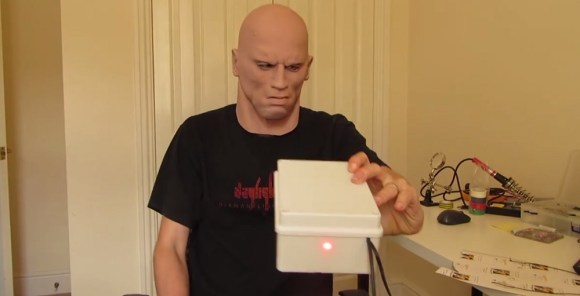
Computer vision based face detection systems are getting better every day. Authorities have been using face detection and criminal databases for several years now. But what if a person being detected is wearing a mask? High quality masks have been making their way out of Hollywood and into the mainstream. It isn’t too far-fetched to expect someone to try to avoid detection using such a mask. To combat this, [Neil] has created a system which detects face masks.
The idea is actually rather simple. The human face has a well-defined heat signature. A mask will not have the same signature. Even when worn for hours, a mask still won’t mimic the infrared signature of the human face. The best tool for this sort of job would be a high resolution thermal imaging camera. These cameras are still relatively expensive, so [Neil] used a Melexis MLX90620 64×8 16×4 array sensor. The Melexis sensor is interfaced to an Arduino nano which then connects to a Raspberry Pi via serial.
The Raspberry Pi uses a Pi camera to acquire an image. OpenCV’s face detection is then used to search for faces. If a face is detected, the data from the Melexis sensor is then brought into play. In [Neil’s] proof of concept system, a temperature variance over ambient is all that is needed to detect a real face vs a fake one. As can be seen in the video after the break, the system works rather well. Considering the current climate of government surveillance, we’re both excited and a bit apprehensive to see where this technology will see real world use.















MLX90620 is 16×4. Where did you get 64×8 I can’t see that he is using 8 sensors which would explain your 64×8 ? It is late where I am may I’m missing something.
You’re right, it 16×4 – I did catch and correct this this while writing, so I’m going go to with wordpress’ editor being out of sync. I should have given it one last check though.
Either way – I’ve corrected it in the live article.
You still can’t see through the mask to determine the facial identity of the wearer. So it’s not as helpful as it could be if it were, say, backscatter microwave scanning everyone.
So as long as it doesn’t detect a face, you’re good…
http://cvdazzle.com/
Dressing up like Lady Gaga, to avoid face detection might work, but can you live with all the poker face jokes?
F**k poker face, SMACKER FACE! And on a serious note would this detect facial prosthetics as masks?
So he’s an amateur wannabe asshole government surveillance state bastard? To each his own I guess..
And that makes you….?
Nope, looks more like he’s an intelligent professional researcher. Amateur wannabes generally don’t write books http://www.springer.com/computer/image+processing/book/978-0-387-77625-5
or have dozens of peer-reviewed publications
http://scholar.google.com/scholar?hl=en&q=Yager%2C+Neil&btnG=&as_sdt=1%2C43&as_sdtp=
So do you hate him because he’s a professional (which would be dumb because there’s still quite a bit of hacking that’s done) or hate him because he’s an amateur (which wouldn’t make sense because that’ll be a good number of people that like this site)?
If only – my RasPi is a piece of crap. The OS – it can hardly deal with my external WiFi adapter.
Use a powered USB hub or another adapter. I have no trouble with mine.
They will just have to enter masks in the criminal database.
So just modify the masks to emit heat… not like all CCTV is running thermal imaging as it is very expensive.
Not really viable or obvious, both two important factors :)
Actually, it was proven that it is not very expensive, only greedy companies ask too much money for it. As there is now huge cap between manufacturing cost and sale price, I will expect rapid price fall in surveillance sector for thermal imaging cameras.
so what happens to all the ladies wearing ten lbs of makeup?
It would be interesting to try to combat this. Thermographs don’t directly read temperature–they read emissivity in a certain band of IR light. I wonder if there are materials suitable to build up the IR profile that wouldn’t make the mask look weird in the visual spectrum.